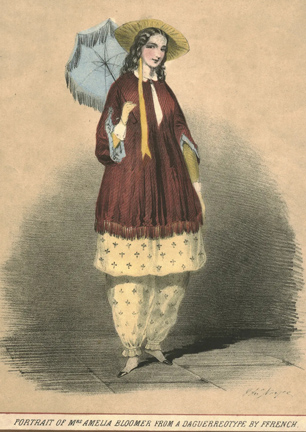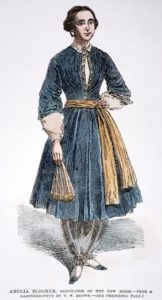FASHION CYCLES
On May 18th the Friends of Auburn Heights hosts the inaugural Auburn Heights After Hours event of 2023. The May event raises the curtain on this year’s themed museum display – Stylized: The Road to Elegance. Before automobile design was influenced by fashion in the early 20th century, it was the bicycle that influenced fashion design in the 19th century! FAH joins Delaware State Parks recognizing May as National Bike Month and urges bike riders to visit Yorklyn Bridge Trail, Oversee Farm Trail or the Mason Dixon Trail during May (Auburn Valley Trail is currently inaccessible while bridge construction is in progress).
 America’s fashion tastes, especially for women during the early 1800s, reflected the tastes and styles of the British Victorian Age that included tight, shape-forming corsets and frilly petticoats. With the coming of the bicycle as personal transportation, fashions were forced to change. Because of exposed moving parts such as chains and spokes, fashion designers were forced to remove excess pleats and frills lest the rider become entangled with the machine. By the later 1800s, the use of bicycles and tricycles, especially in America’s cities, had become a popular form of personal transportation bridging the gap between walking or riding a horse.
America’s fashion tastes, especially for women during the early 1800s, reflected the tastes and styles of the British Victorian Age that included tight, shape-forming corsets and frilly petticoats. With the coming of the bicycle as personal transportation, fashions were forced to change. Because of exposed moving parts such as chains and spokes, fashion designers were forced to remove excess pleats and frills lest the rider become entangled with the machine. By the later 1800s, the use of bicycles and tricycles, especially in America’s cities, had become a popular form of personal transportation bridging the gap between walking or riding a horse.
America’s dependence on bicycles is cited by some historians as spawning the development of a very controversial new article of clothing in the mid-1800s. What was this article of clothing? As a hint, the item was associated with a well-known woman’s rights activist of the era who made this manner of dress popular.
Answer
 If one reflects on society in the 1800s, it was a man’s duty to earn a reputable living and provide for his family while women were expected to operate the household and raise children. The era held defined expectations for masculine and feminine appearances. Towards the end of the Victorian Age, bicycles offered women access to an independent personal transportation option since sidesaddle riding on a horse was not comfortable nor considered very lady-like. A major issue for women riding a bicycle or tricycle was the flowing fabric embellishments and restrictive nature of a female’s wardrobe.
If one reflects on society in the 1800s, it was a man’s duty to earn a reputable living and provide for his family while women were expected to operate the household and raise children. The era held defined expectations for masculine and feminine appearances. Towards the end of the Victorian Age, bicycles offered women access to an independent personal transportation option since sidesaddle riding on a horse was not comfortable nor considered very lady-like. A major issue for women riding a bicycle or tricycle was the flowing fabric embellishments and restrictive nature of a female’s wardrobe.
In the 1850s, Elizabeth Smith Miller wore what was known as “Turkish Dress” to the home of Amelia Bloomer (pictured in the drawings). Instead of the acceptable floor-length skirt worn over layers of heavily starched petticoats resting on panniers or crinoline hoops, Miller wore a just-below-the-knee-length dress with a very baggy set of highly decorated pants underneath. Amelia Bloomer loved Miller’s fashion sense, and after adopting it for herself with modifications, described it in her temperance journal “The Lily”. Soon newspapers had picked up Bloomer’s description lamenting the virtues and practicality of a short skirt worn over pants.
 Because Bloomer described how to make the frilly bloomer pant based off men’s pant designs, and accompany the pant with a cut-down dress, it was not difficult for American women to start making “bloomers” by recycling their old dresses where the hemline had deteriorated from dragging on the ground. Soon women wearing bloomers became all the rage to the vocal objection of many. With its development, the ‘bloomer’ article of clothing was about to play a central role in reshaping bicycle-riding America.
Because Bloomer described how to make the frilly bloomer pant based off men’s pant designs, and accompany the pant with a cut-down dress, it was not difficult for American women to start making “bloomers” by recycling their old dresses where the hemline had deteriorated from dragging on the ground. Soon women wearing bloomers became all the rage to the vocal objection of many. With its development, the ‘bloomer’ article of clothing was about to play a central role in reshaping bicycle-riding America.
The wearing of short skirts with bloomers made bicycle riding, and even horseback riding using a regular saddle, a lot easier for women. The downside was the furor created at seeing women’s legs and bare ankles in public in the still Victorian-minded America of the later 1800s. Many feared the bloomer would incite the moral decay of America’s feminine population. “Bloomerism” in the mid-1800s was as big an issue in that era as discussions on gender identity and transgender lifestyles are today.
Wearing of bloomers not only signaled a woman’s increased independence, it became part of a grassroots effort that resulted in the addition of the 19th Amendment to the Constitution giving women the right to vote. Several American cities enacted laws making it illegal for anyone to dress in the wardrobe of the opposite sex while churches and other public institutions declined admittance to women wearing bloomer-like wardrobes.
 As bloomers became socially acceptable in the later 1800s, they were adopted in varying stylings for hiking and other activities. Made of wool in the winter and cotton in the summer, bloomers could be plain looking and of simple design for around-the-house activities but made from silks and expensive fabrics adorned with lace, ruffles, and tassels for more formal occasions. Constructed of decorative fabrics for more luxurious activities and outings, the bloomer became a fashion icon of the era. It would not be until the 1920s and the marrying of fashion and automobile design that the bloomer transitioned to a pant design like menswear.
As bloomers became socially acceptable in the later 1800s, they were adopted in varying stylings for hiking and other activities. Made of wool in the winter and cotton in the summer, bloomers could be plain looking and of simple design for around-the-house activities but made from silks and expensive fabrics adorned with lace, ruffles, and tassels for more formal occasions. Constructed of decorative fabrics for more luxurious activities and outings, the bloomer became a fashion icon of the era. It would not be until the 1920s and the marrying of fashion and automobile design that the bloomer transitioned to a pant design like menswear.
With the development of the motorcarriage at the start of the 1900s, fashion tastes adapted again to the needs of personal transportation. At the start of the 20th century the autocarriage in its various forms had begun to replace both the bicycle and horse for independent personal transportation. The term autocarriage was coined because these vehicles resembled horse-drawn carriages but were moved with steam, electric, or internal combustion power sources. By the dawn of the Roaring 1920s, the automobile had clearly established itself as the replacement for the bicycle and horse. As a result, the automobile sales market had become stagnant as those who needed an automobile, already owned one. If the family vehicle was paid off, the owner was unlikely to obtain a replacement as long as it remained functional.
In the late 19-teens the American automobile had become so well defined that individuals had devised kits to repurpose the vehicles with tracks and skis for winter use, to power a temporary saw mill, and to do other tasks besides transporting a family. The automobile, upon reaching ‘adulthood’ in the 19-teens, had transitioned from a novelty idea to a cookie-cutter standard product that could be accessorized in nearly infinite ways.
A visit to the Marshall Steam Museum reveals that not much changed in automotive artistic design between the 1918 Model 735 and the 1924 Model 750. Looking at Stanley Motor Carriage Company’s competition, we find that Buick, Chevrolet, Dodge, Ford, Lincoln, Nash, Packard, Oldsmobile, Plymouth, and others relied on fenders, axles, lighting, and wheels all of which were largely catalog purchases from mass producing manufacturers. Only expensive custom design cars had these items custom designed where the added cost added to the vehicle’s price tag was acceptable. It was engine development and the body and interiors from coach and carriage makers that made lesser, cookie-cutter identical, low-cost vehicles distinctive as well as widely available to middle-class America.
Facing a slowing sales forecast towards the end of the Roaring 20’s for automobiles, manufacturers looked for a means to stimulate sales. In September 1927, General Motors president Alfred P. Sloan, Jr. wrote to Fisher Body president William Fisher that “I think that the future of General Motors will be measured by the attractiveness that we put in the bodies from the standpoint of luxury of appointment, the degree to which they please the eye, both in contour and in color scheme, also the degree to which we are able to make them different from our competition.” The end of volume-production at the lowest cost, and “any color you want as long as its black”, days were numbered.
 The result was the stitching together of the fashion world with automotive design. Cars would now complement fashion and fashion would complement cars. GM tapped Harley Jarvis Earl (pictured with his designers – 1893-1969) to integrate ‘fashion’ with automobile design. Earl revolutionized automotive design giving rise to features like tail fins, wrap-around windshields, and iconic sweeping lines on body panels. Earl designed vehicles were often referenced as artistic sculptures on motion.
The result was the stitching together of the fashion world with automotive design. Cars would now complement fashion and fashion would complement cars. GM tapped Harley Jarvis Earl (pictured with his designers – 1893-1969) to integrate ‘fashion’ with automobile design. Earl revolutionized automotive design giving rise to features like tail fins, wrap-around windshields, and iconic sweeping lines on body panels. Earl designed vehicles were often referenced as artistic sculptures on motion.
Earl insured that female fashion designers had input into his automotive designs. Make-up mirrors, glove compartments, toy compartments built into the backs of front seats for kids riding in the back seat, and other offerings became standard offerings. Magazines such as Vogue and others featured women’s fashions displayed alongside the advertised automobiles. The design revolution that Earl started resulted in the family flivver being seen as passe’ within a few years and needing to be replaced by the newest model loaded with amenities.
The FAH’s Marshall Steam Museum featured display this summer explores the influences of fashion and automotive styling. Explore the display to learn how over a short period of time, Americans were encouraged to replace their automobiles and wardrobes regularly; not because they had worn out, but because the look had aged and become dowdy or frumpy. Soon the used vehicle market was born and what folks witnessed in their magazines and in talking pictures on silver-screens, influenced what they purchased in fashion, automobiles, appliances, and so much more. We invite you to visit Auburn Valley State Park this summer during a Steamin’ Day, Auburn Heights After Hours, or an open house day to experience Stylized: The Road to Elegance.

